key FIAT PALIO 2003 178 / 1.G India Version Owner's Manual
[x] Cancel search | Manufacturer: FIAT, Model Year: 2003, Model line: PALIO, Model: FIAT PALIO 2003 178 / 1.GPages: 156, PDF Size: 6.27 MB
Page 51 of 156
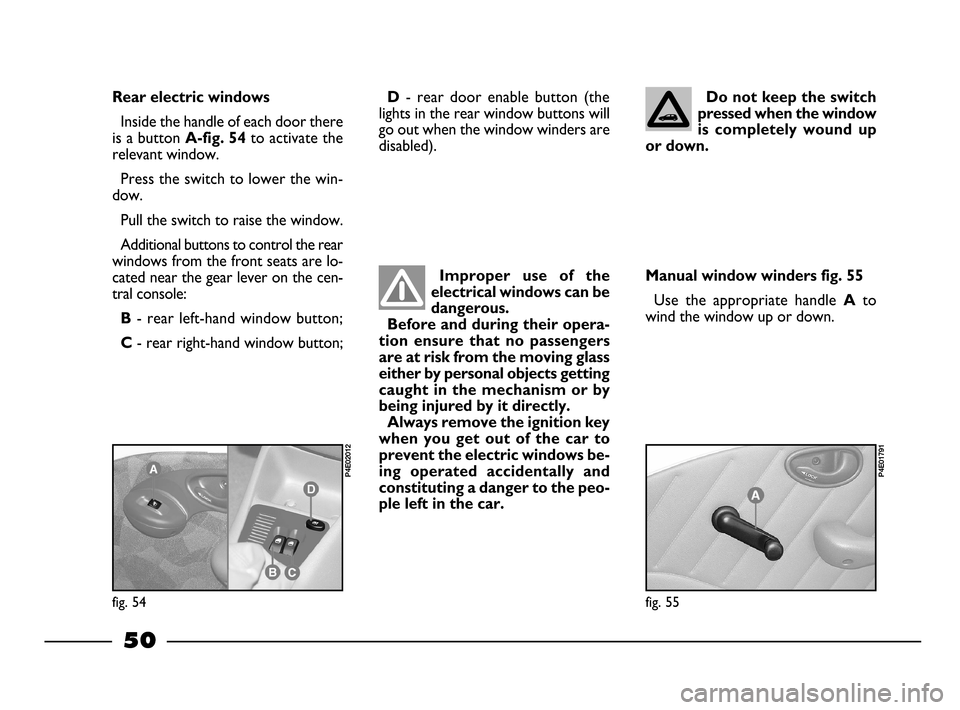
50
Do not keep the switch
pressed when the window
is completely wound up
or down.
Improper use of the
electrical windows can be
dangerous.
Before and during their opera-
tion ensure that no passengers
are at risk from the moving glass
either by personal objects getting
caught in the mechanism or by
being injured by it directly.
Always remove the ignition key
when you get out of the car to
prevent the electric windows be-
ing operated accidentally and
constituting a danger to the peo-
ple left in the car.
fig. 54
P4E02012
Rear electric windows
Inside the handle of each door there
is a button
A-fig. 54to activate the
relevant window.
Press the switch to lower the win-
dow.
Pull the switch to raise the window.
Additional buttons to control the rear
windows from the front seats are lo-
cated near the gear lever on the cen-
tral console:
B - rear left-hand window button;
C - rear right-hand window button;
D - rear door enable button (the
lights in the rear window buttons will
go out when the window winders are
disabled).
Manual window winders fig. 55
Use the appropriate handleA to
wind the window up or down.
fig. 55
P4E01791
20-63 03/03/2003 06:03 PM Page 50
Page 52 of 156
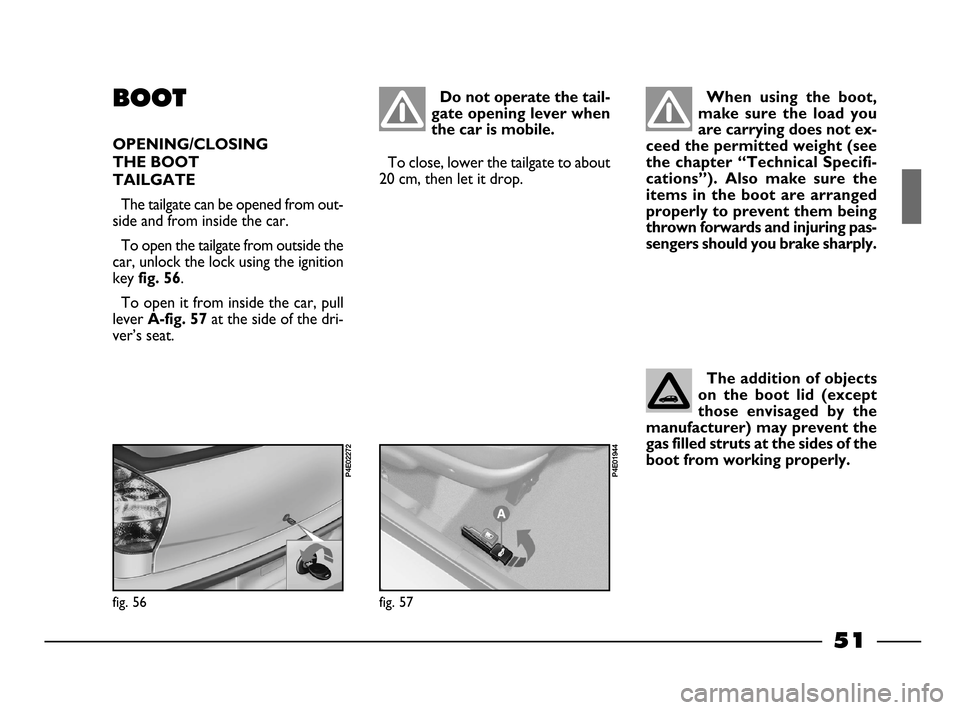
51
When using the boot,
make sure the load you
are carrying does not ex-
ceed the permitted weight (see
the chapter “Technical Specifi-
cations”). Also make sure the
items in the boot are arranged
properly to prevent them being
thrown forwards and injuring pas-
sengers should you brake sharply.BOOT
OPENING/CLOSING
THE BOOT
TAILGATE
The tailgate can be opened from out-
side and from inside the car.
To open the tailgate from outside the
car, unlock the lock using the ignition
key
fig. 56.
To open it from inside the car, pull
lever
A-fig. 57at the side of the dri-
ver’s seat.
Do not operate the tail-
gate opening lever when
the car is mobile.
To close, lower the tailgate to about
20 cm, then let it drop.
fig. 56
P4E02272
fig. 57
P4E01944
The addition of objects
on the boot lid (except
those envisaged by the
manufacturer) may prevent the
gas filled struts at the sides of the
boot from working properly.
20-63 03/03/2003 06:03 PM Page 51
Page 56 of 156
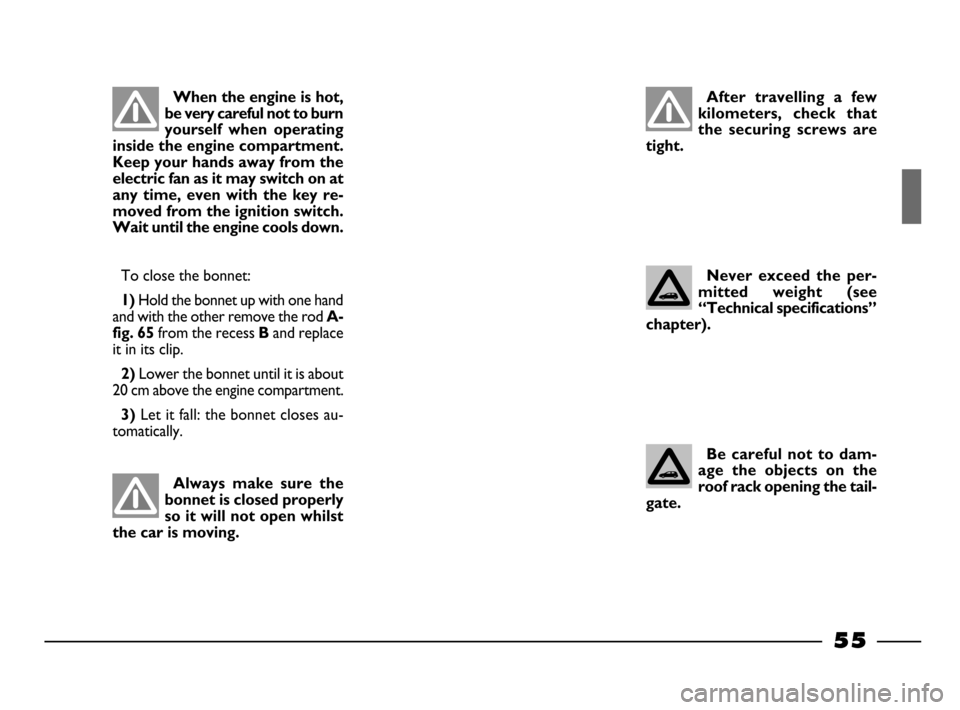
55
To close the bonnet:
1) Hold the bonnet up with one hand
and with the other remove the rod
A-
fig. 65
from the recess Band replace
it in its clip.
2)Lower the bonnet until it is about
20 cm above the engine compartment.
3) Let it fall: the bonnet closes au-
tomatically.
ROOF RACK
Move the door weather strips aside
in the points shown in
fig. 66to reach
the fasteners.
When the engine is hot,
be very careful not to burn
yourself when operating
inside the engine compartment.
Keep your hands away from the
electric fan as it may switch on at
any time, even with the key re-
moved from the ignition switch.
Wait until the engine cools down.
Always make sure the
bonnet is closed properly
so it will not open whilst
the car is moving.
After travelling a few
kilometers, check that
the securing screws are
tight.
Never exceed the per-
mitted weight (see
“Technical specifications”
chapter).
Be careful not to dam-
age the objects on the
roof rack opening the tail-
gate.
20-63 03/03/2003 06:03 PM Page 55
Page 60 of 156

59
When the ignition key is
turned to MAR, the indi-
cator û
comes on after
about four seconds. If the warn-
ing light does not come on, or it
remains on while travelling go
immediately to a Fiat Dealership.
Do not apply stickers or
other objects on the
steering wheel. Do not
travel with items on your lap, in
front of you or with a pipe, pencil
etc. between your lips. In a colli-
sion where the airbag is triggerd
you could seriously hurt yourself
GENERAL WARNINGS
It may happen that the air bag
inflates if the car is involved in
hard impacts or collisions in the
area of the underbody, for exam-
ple hard knocks against steps,
kerbs or raised road bumps, or if
the car drops into large pot-holes
or road dips.
When the airbag inflates it
emits a small amount of dust and
smoke. This dust and smoke is
harmless and it is not the begin-
ning of a fire.
If the warning light
ûcomes on
while travelling (indication of a
fault) go as soon as possible to a
Fiat Dealership.
The air bag system is valid for 10
years. When the expiry date is
near, contact a Fiat Dealership.
Should an accident occur in
which the airbag is activated,
take the car to a Fiat Dealership
to have the whole device re-
placed (electronic control unit,
seat belts, pretensioners) and tohave the electrical system
checked.
Any diagnostic, repair or re-
placement operations concerning
the airbag system must exclu-
sively be carried out at a Fiat
Dealership.
If you are having the car
scrapped, have the airbag system
deactivated at a Fiat Dealership.
If the car changes hands, the
new owner must be made aware
of the indications given above and
be given this Owner’s Handbook.
Pretensioners (if electronically
controlled) and air bag are trig-
gered by the electronic control
unit according to different types
of impact. Therefore, if some de-
vices do not trigger this does not
indicate a fault in the system.
20-63 03/03/2003 06:03 PM Page 59
Page 61 of 156
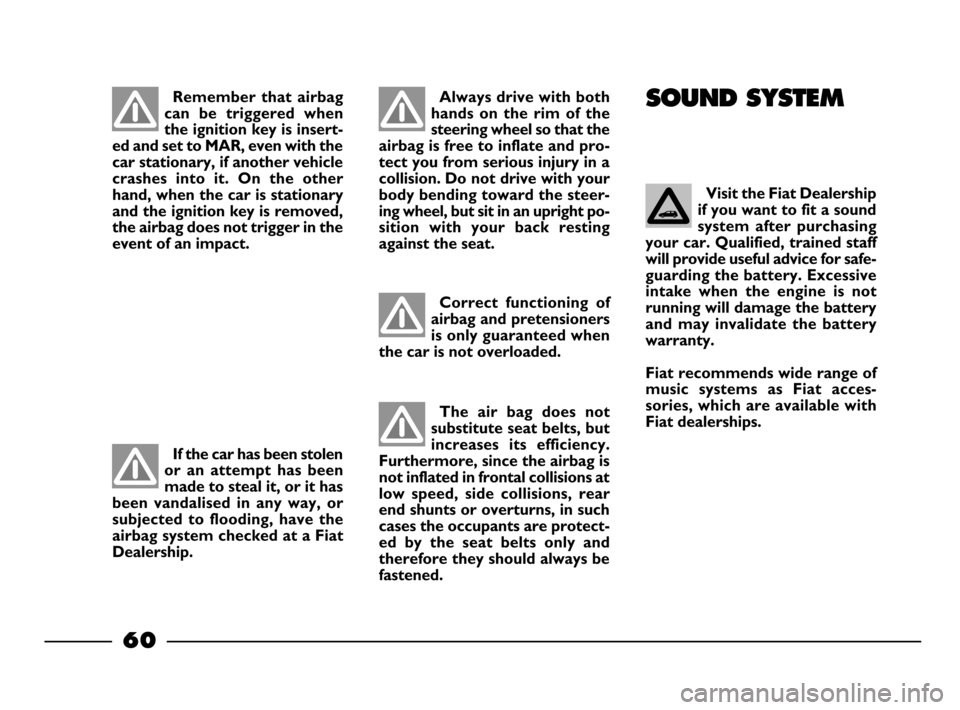
60
Always drive with both
hands on the rim of the
steering wheel so that the
airbag is free to inflate and pro-
tect you from serious injury in a
collision. Do not drive with your
body bending toward the steer-
ing wheel, but sit in an upright po-
sition with your back resting
against the seat.
If the car has been stolen
or an attempt has been
made to steal it, or it has
been vandalised in any way, or
subjected to flooding, have the
airbag system checked at a Fiat
Dealership.The air bag does not
substitute seat belts, but
increases its efficiency.
Furthermore, since the airbag is
not inflated in frontal collisions at
low speed, side collisions, rear
end shunts or overturns, in such
cases the occupants are protect-
ed by the seat belts only and
therefore they should always be
fastened.Correct functioning of
airbag and pretensioners
is only guaranteed when
the car is not overloaded.SOUND SYSTEMRemember that airbag
can be triggered when
the ignition key is insert-
ed and set to MAR, even with the
car stationary, if another vehicle
crashes into it. On the other
hand, when the car is stationary
and the ignition key is removed,
the airbag does not trigger in the
event of an impact.
Visit the Fiat Dealership
if you want to fit a sound
system after purchasing
your car. Qualified, trained staff
will provide useful advice for safe-
guarding the battery. Excessive
intake when the engine is not
running will damage the battery
and may invalidate the battery
warranty.
Fiat recommends wide range of
music systems as Fiat acces-
sories, which are available with
Fiat dealerships.
20-63 03/03/2003 06:03 PM Page 60
Page 66 of 156
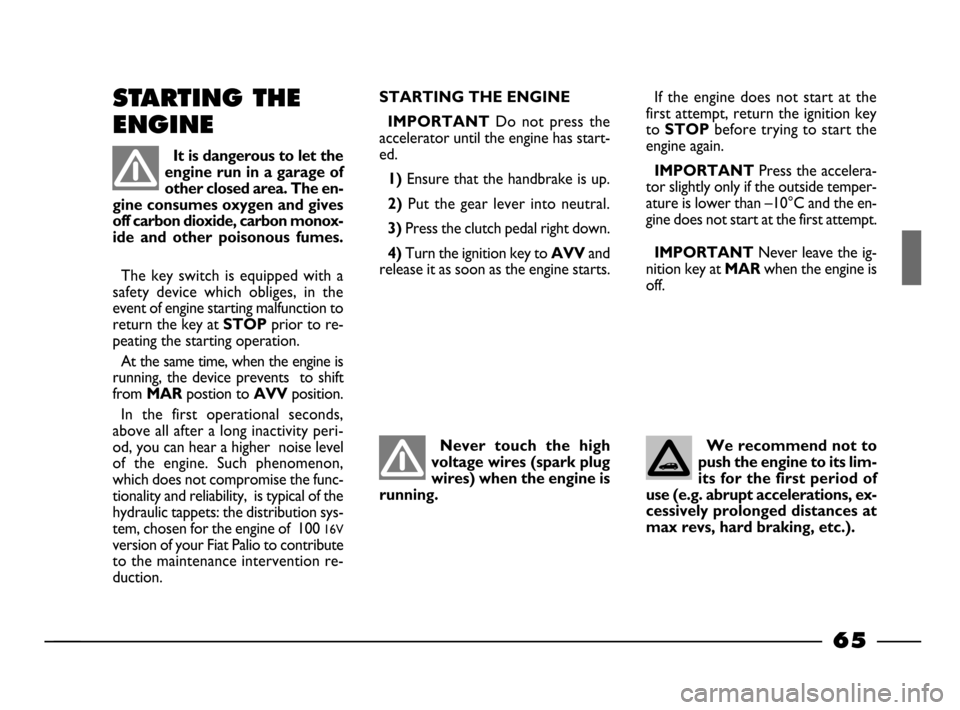
65
The key switch is equipped with a
safety device which obliges, in the
event of engine starting malfunction to
return the key at
STOP prior to re-
peating the starting operation.
At the same time, when the engine is
running, the device prevents to shift
from
MAR postion to AVV position.
In the first operational seconds,
above all after a long inactivity peri-
od, you can hear a higher noise level
of the engine. Such phenomenon,
which does not compromise the func-
tionality and reliability, is typical of the
hydraulic tappets: the distribution sys-
tem, chosen for the engine of 100
16V
version of your Fiat Palio to contribute
to the maintenance intervention re-
duction.
STARTING THE ENGINE
IMPORTANT
Do not press the
accelerator until the engine has start-
ed.
1) Ensure that the handbrake is up.
2) Put the gear lever into neutral.
3)Press the clutch pedal right down.
4) Turn the ignition key to AVVand
release it as soon as the engine starts.If the engine does not start at the
first attempt, return the ignition key
to
STOP before trying to start the
engine again.
IMPORTANT Press the accelera-
tor slightly only if the outside temper-
ature is lower than –10°C and the en-
gine does not start at the first attempt.
IMPORTANTNever leave the ig-
nition key at
MARwhen the engine is
off.
Never touch the high
voltage wires (spark plug
wires) when the engine is
running.
It is dangerous to let the
engine run in a garage of
other closed area. The en-
gine consumes oxygen and gives
off carbon dioxide, carbon monox-
ide and other poisonous fumes.
STARTING THE
ENGINE
We recommend not to
push the engine to its lim-
its for the first period of
use (e.g. abrupt accelerations, ex-
cessively prolonged distances at
max revs, hard braking, etc.).
64-79 03/03/2003 06:45 PM Page 65
Page 67 of 156
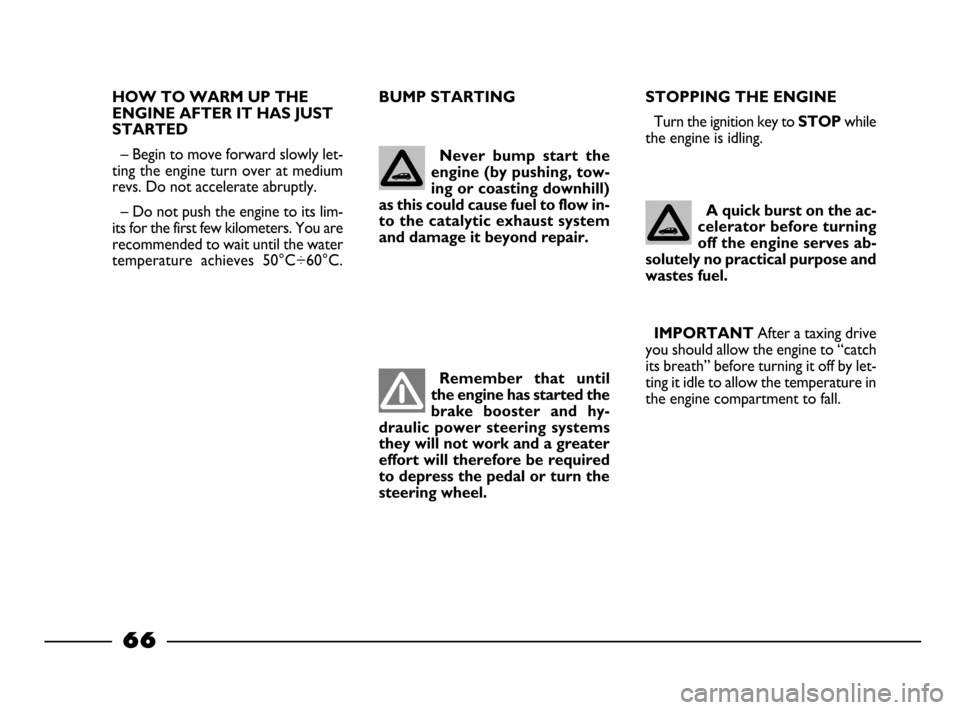
66
BUMP STARTING STOPPING THE ENGINE
Turn the ignition key to STOPwhile
the engine is idling.
HOW TO WARM UP THE
ENGINE AFTER IT HAS JUST
STARTED
– Begin to move forward slowly let-
ting the engine turn over at medium
revs. Do not accelerate abruptly.
– Do not push the engine to its lim-
its for the first few kilometers. You are
recommended to wait until the water
temperature achieves 50°C÷60°C.
Remember that until
the engine has started the
brake booster and hy-
draulic power steering systems
they will not work and a greater
effort will therefore be required
to depress the pedal or turn the
steering wheel.Never bump start the
engine (by pushing, tow-
ing or coasting downhill)
as this could cause fuel to flow in-
to the catalytic exhaust system
and damage it beyond repair.
A quick burst on the ac-
celerator before turning
off the engine serves ab-
solutely no practical purpose and
wastes fuel.
IMPORTANT
After a taxing drive
you should allow the engine to “catch
its breath” before turning it off by let-
ting it idle to allow the temperature in
the engine compartment to fall.
64-79 03/03/2003 06:45 PM Page 66
Page 68 of 156
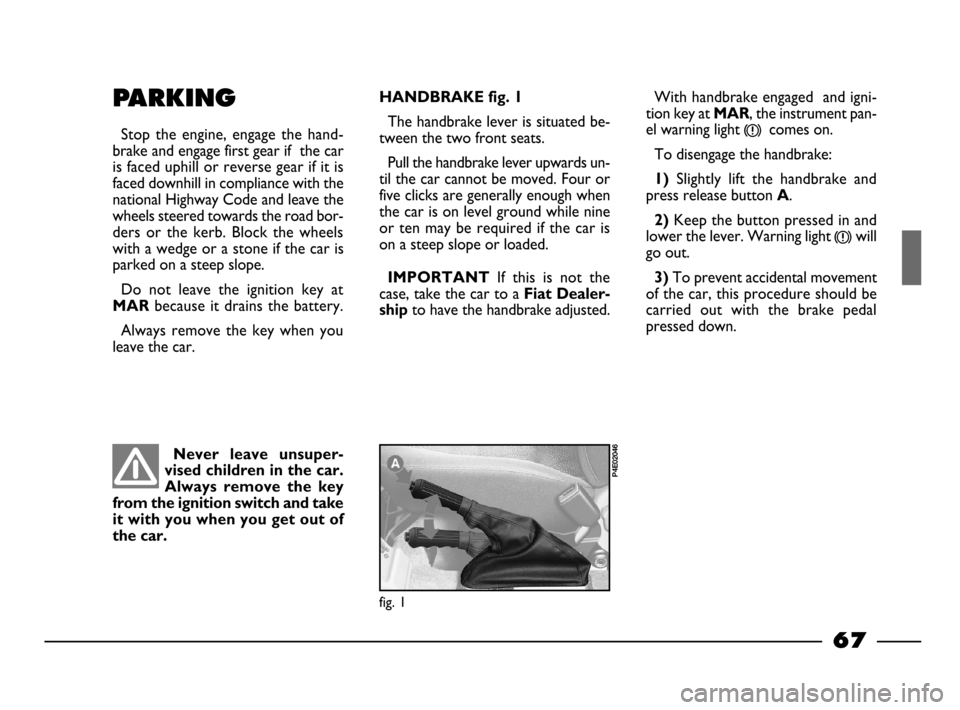
67
With handbrake engaged and igni-
tion key at
MAR, the instrument pan-
el warning light
x
comes on.
To disengage the handbrake:
1)Slightly lift the handbrake and
press release button
A.
2)Keep the button pressed in and
lower the lever. Warning light
x
will
go out.
3)To prevent accidental movement
of the car, this procedure should be
carried out with the brake pedal
pressed down.
HANDBRAKE fig. 1
The handbrake lever is situated be-
tween the two front seats.
Pull the handbrake lever upwards un-
til the car cannot be moved. Four or
five clicks are generally enough when
the car is on level ground while nine
or ten may be required if the car is
on a steep slope or loaded.
IMPORTANTIf this is not the
case, take the car to a
Fiat Dealer-
ship
to have the handbrake adjusted.
Never leave unsuper-
vised children in the car.
Always remove the key
from the ignition switch and take
it with you when you get out of
the car.
fig. 1
P4E02046
PARKING
Stop the engine, engage the hand-
brake and engage first gear if the car
is faced uphill or reverse gear if it is
faced downhill in compliance with the
national Highway Code and leave the
wheels steered towards the road bor-
ders or the kerb. Block the wheels
with a wedge or a stone if the car is
parked on a steep slope.
Do not leave the ignition key at
MARbecause it drains the battery.
Always remove the key when you
leave the car.
64-79 03/03/2003 06:45 PM Page 67
Page 73 of 156
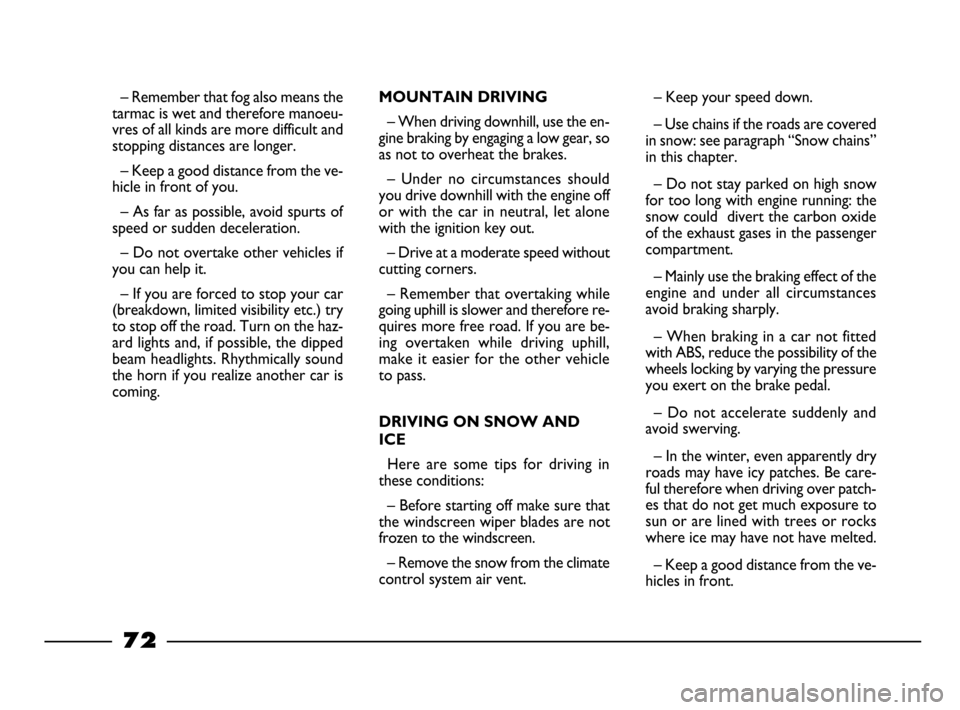
72
– Remember that fog also means the
tarmac is wet and therefore manoeu-
vres of all kinds are more difficult and
stopping distances are longer.
– Keep a good distance from the ve-
hicle in front of you.
– As far as possible, avoid spurts of
speed or sudden deceleration.
– Do not overtake other vehicles if
you can help it.
– If you are forced to stop your car
(breakdown, limited visibility etc.) try
to stop off the road. Turn on the haz-
ard lights and, if possible, the dipped
beam headlights. Rhythmically sound
the horn if you realize another car is
coming.MOUNTAIN DRIVING
– When driving downhill, use the en-
gine braking by engaging a low gear, so
as not to overheat the brakes.
– Under no circumstances should
you drive downhill with the engine off
or with the car in neutral, let alone
with the ignition key out.
– Drive at a moderate speed without
cutting corners.
– Remember that overtaking while
going uphill is slower and therefore re-
quires more free road. If you are be-
ing overtaken while driving uphill,
make it easier for the other vehicle
to pass.
DRIVING ON SNOW AND
ICE
Here are some tips for driving in
these conditions:
– Before starting off make sure that
the windscreen wiper blades are not
frozen to the windscreen.
– Remove the snow from the climate
control system air vent. – Keep your speed down.
– Use chains if the roads are covered
in snow: see paragraph “Snow chains”
in this chapter.
– Do not stay parked on high snow
for too long with engine running: the
snow could divert the carbon oxide
of the exhaust gases in the passenger
compartment.
– Mainly use the braking effect of the
engine and under all circumstances
avoid braking sharply.
– When braking in a car not fitted
with ABS, reduce the possibility of the
wheels locking by varying the pressure
you exert on the brake pedal.
– Do not accelerate suddenly and
avoid swerving.
– In the winter, even apparently dry
roads may have icy patches. Be care-
ful therefore when driving over patch-
es that do not get much exposure to
sun or are lined with trees or rocks
where ice may have not have melted.
– Keep a good distance from the ve-
hicles in front.
64-79 03/03/2003 06:45 PM Page 72
Page 75 of 156
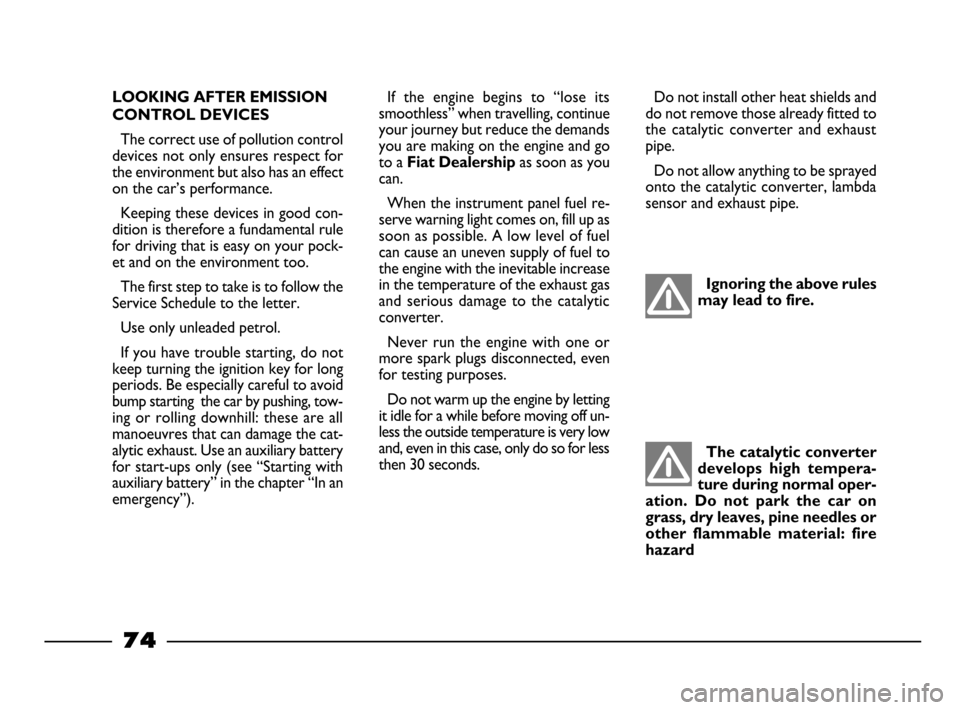
74
If the engine begins to “lose its
smoothless” when travelling, continue
your journey but reduce the demands
you are making on the engine and go
to a
Fiat Dealership as soon as you
can.
When the instrument panel fuel re-
serve warning light comes on, fill up as
soon as possible. A low level of fuel
can cause an uneven supply of fuel to
the engine with the inevitable increase
in the temperature of the exhaust gas
and serious damage to the catalytic
converter.
Never run the engine with one or
more spark plugs disconnected, even
for testing purposes.
Do not warm up the engine by letting
it idle for a while before moving off un-
less the outside temperature is very low
and, even in this case, only do so for less
then 30 seconds.Do not install other heat shields and
do not remove those already fitted to
the catalytic converter and exhaust
pipe.
Do not allow anything to be sprayed
onto the catalytic converter, lambda
sensor and exhaust pipe.
Ignoring the above rules
may lead to fire.
The catalytic converter
develops high tempera-
ture during normal oper-
ation. Do not park the car on
grass, dry leaves, pine needles or
other flammable material: fire
hazard
LOOKING AFTER EMISSION
CONTROL DEVICES
The correct use of pollution control
devices not only ensures respect for
the environment but also has an effect
on the car’s performance.
Keeping these devices in good con-
dition is therefore a fundamental rule
for driving that is easy on your pock-
et and on the environment too.
The first step to take is to follow the
Service Schedule to the letter.
Use only unleaded petrol.
If you have trouble starting, do not
keep turning the ignition key for long
periods. Be especially careful to avoid
bump starting the car by pushing, tow-
ing or rolling downhill: these are all
manoeuvres that can damage the cat-
alytic exhaust. Use an auxiliary battery
for start-ups only (see “Starting with
auxiliary battery” in the chapter “In an
emergency”).
64-79 03/03/2003 06:45 PM Page 74